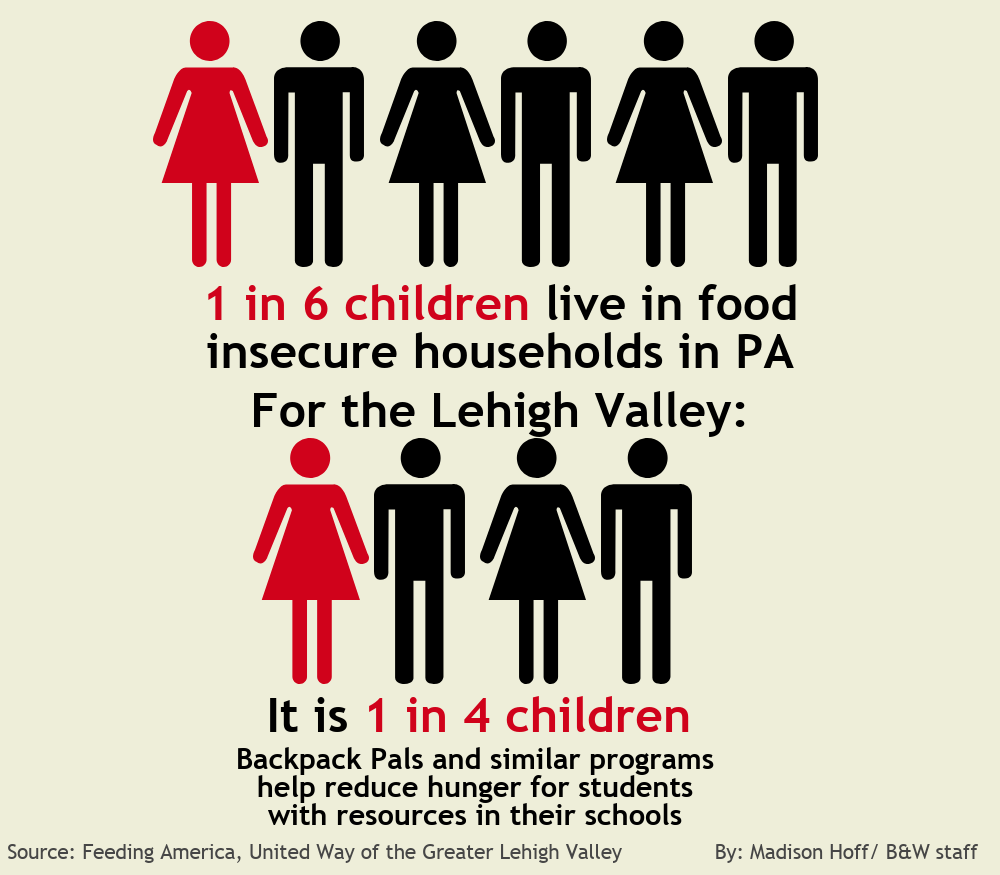At the end of every month, households in the Lehigh Valley have to ask themselves the same question: What bills should be paid first?
Susan Dalandan, the coordinator of the Lehigh Valley Food Policy Council, said families typically pay their rent first. Then the car payment. Then the water bill. Electric bill. Gas bill.
“At the end of your paycheck, you don’t have enough money left for food,” Dalandan said.
She said parents do not consider health care or food as priorities. Without money reserved for food, the families become food insecure, which means they do not have consistent and sufficient access to food. Dalandan said parents want to have food stability for their families, but sometimes they fall on hard times or other bills become more important.
But no money for food means children have to go to school hungry.

Data from Feeding America, a domestic hunger-relief organization, shows that one in six children in the United States are food insecure.The Greater Lehigh Valley is above average in food insecurity for children, with one in four considered insecure, according to The United Way of the Greater Lehigh Valley.
In the Easton area school district, students receive free breakfast and lunch everyday. Charlene Symia, the building principal of Easton Area Middle School, said the students are thankful for these meals because a lot of their families fall just above the required income level to qualify for free or reduced lunches.
Rebecca Miller, the Backpack Pals Coordinator at Family Connection of Easton, said for many of these students, the free breakfast and lunch are the only two meals they will eat each day.
According to Economic Research Service, households with children were above the national average of food insecurity, especially in single parent homes. In 2017, 15.7 percent of homes with children were food insecure.
Nancy Walters, the founder of Easton Hunger Coalition, said food insecurity is a problem for children because they cannot fix the situation themselves. As a result, they are even more vulnerable to hunger.
“We can measure food insecurity by virtue of the fact that (households) are relying on emergency food,” Walters said. “It is no longer an emergency – for too many, it’s reliability.”
Although the Easton school district provides meals during the week, Symia said she worries about what students eat on the weekends. To help address this problem, she brought Backpack Pals to their school. Through the program, students can take home bags filled with nutritious items that they can prepare themselves.
Walters created Backpack Pals in 2012 alongside two other partners. It has now been part of the school for five years and is run by Family Connection of Easton, which distributed 1,080 backpacks last year.
Similar programs can be found across the nation. The Bethlehem school district implemented Backpack Pals after a mother was inspired by the program in Easton. Similarly, Second Harvest creates backpacks for more than 500 children a year for 12 locations in the Lehigh Valley and Northeast Pennsylvania region under their Backpack Buddies program.
During the holidays, Symia said the community joins together to prepare bags for some of the families. Last year, they were able to make between 30 and 35 bags that included everything needed for a Thanksgiving meal. The staff donated turkeys, stuffing and potatoes.
LuAnn DeRoso, a parent in Easton, said Thanksgiving was the first long holiday that her daughter received a donation from the school. She said her bag was filled with turkey, stuffing and cans for preparing a holiday meal.
“It’s great because sometimes people fall into hard financial times,” DeRoso said. “But at least we have the bags to help out a little.”
Although Backpack Pals helps some students, it does not help everyone in need. To reach more students, Easton Area Middle School opened a food pantry on April 4, funded by the Greater Lehigh Valley Auto Dealers Association, as another effort to get food and other necessities directly to children.
Carolyn Serva, the executive director of Family Connection, said members of the organization thought a pantry would be a good resource for students because they can comfortably take what they need without their friends knowing.
“We felt that an anonymous process was best, being that they probably wouldn’t want to be singled out by their peers,” Serva said. “The elementary children like showing off their backpacks but the other grades like the (anonymity).”
Symia said a guidance counselor can walk students to the pantry, but it is difficult to know when a student needs to visit it. She said it is easier for teachers to know when students need new clothes if their outfits are worn or tattered.
“Children won’t tell you all the time that they’re hungry,” Symia said. “The food pantry will afford them the opportunity to access food supplies with no fear of repercussions from anyone.”
Serva said the goal is to keep students in school while providing them with the tools necessary to stay healthy within the school building itself. This way, children only have to worry about schoolwork.
“We’re not just giving them academics,” Symia said. “We’re giving them academics, social (lives), resources — our roles have expanded generally.”





Comment policy
Comments posted to The Brown and White website are reviewed by a moderator before being approved. Incendiary speech or harassing language, including comments targeted at individuals, may be deemed unacceptable and not published. Spam and other soliciting will also be declined.
The Brown and White also reserves the right to not publish entirely anonymous comments.